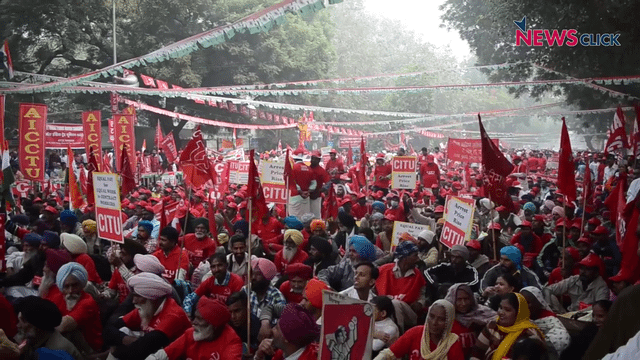They came in the thousands. They came from all over India. They came to demand their rights. They were in Delhi for three days.
They were the workers of India, the mazdoors, the oppressed labour. Amongst them were hundreds of women, as vocal, as aware of their rights as the men. They came in protest against the anti-worker policies of the current government, to raise an united voice, to demand their rights.
They were blacked out by the big media. Not a word appeared on television channels, in the major newspapers, about this huge protest in the heart of the national capital. It was as if it did not happen where the media was concerned, redefining news in its desire to please the corporate and political bosses.
The video by Newsclick captures the crowd, the anger, the enthusiasm. And yet this was not seen as news by the big media, all owned by corporate houses and all working to preserve the political-business nexus.
The workers come in the way of this corporate-political nexus. This is the first reason why the huge rally that continued for three days, with the workers drawn from all segments of life—industrial, agrarian, mining—giving an insight into the India that seems to have been factored out of the headlines of the corporate driven media. Both suspicious and fearful of the organised trade union movement, with the massive mobilisation by the Left parties in particular, adding to the rich and powerful paranoia.
Media houses and corporate houses worked to destroy the trade unions in newspapers through the 19980-1990’s to ensure that the press workers and the working journalists were contained and controlled. Television ensured a crippling blow with contracts favouring the management replacing the daily wage board pay scales. And as the trade unions disappeared one by one in the newspaper industry , the management control over the workers intensified, with even editors now hired and fired at will with merit and capability hardly being the qualification.
Second, the workers are seen as anti-employers. Their demands thus increase the pressure on the business houses, and the governments that are resistant to conceding what the poor of India need and want. For instance on the last day Parliament street had turned into a sea of women asking for better wages, health and education care, all pretty low on the list of those who are in government and those who control government. Hence the media, that works under the employers, decided not to give space to over a lakh of workers and their demands.As pressure makes the ‘employers’ uncomfortable and thus is has become the duty of the owned and subservient media to ensure that comfort levels are not damaged.
Wages was a major issue. No revision of wages, low wages, undue cut of wages, and various methods used to ensure that the workers do not get what is their due.
“Jo hamse takrayega, choor choor ho jayega” shouted the workers as their leaders told the handful of reporters who were there representing alternative media that the central employees felt cheated, betrayed, over the 7th Planning Commission. They spoke of how work had increased manifold, wages had not, as government jobs were not filled and vacancies continued. There has been no wage revisions for instance of postal employees working in the rural areas, no confirmations, no revision. Trade union facilities are being withdrawn instead, and the government-corporate nexus is working in unison to marginalise the workers.
Those who own the newspapers too feel vulnerable against workers unity, and hence are at one with the nexus to black out the poor of India.
Three, workers are India’s toiling masses from coal mines, to anganwadis, to landless labour. They are not the consumer class, and bring no direct benefit to the advertising and TRP linked revenues of the big media. Giving them even a passing mention is thus worthless, as it brings no money and instead for the reasons cited above actually cuts into the revenue with the workers demanding a fair slice of the growth pie. By giving them space the big media does not want to justify or highlight their cause. Somehow the ostrich like approach has replaced conscientious and fair reportage, a belief that if the media ignores an event and buries its head in the sand, it will pass.
But as the workers said without hesitation, they have no respect left for the media. “Who cares whether they report or do not, your reporters are just bought by big money,” a woman from ASHA said smiling through the apparent belligerence. There was not a single voice that spoke of the media with any level of regret saying instead, “why should we bother, you are not going to write about us here or in our work place, you are not interested but the people's voice cannot be stopped. A trade union leader pointed out, “we were here a few years ago, over a lakh of workers right outside Parliament but your media did not even notice us.”





